JD's Midlife Tools For Living Practices, LLC



Image by free pic
This really is a very important holiday this day of giving thanks. Not only is it an opportunity to spend time with family and friends over an especially delicious dinner but, it is a reminder itself of the importance that giving thanks, that gratitude has in our lives.
According to Harvard Health Giving thanks can make you happier studies have shown that “gratitude is strongly and consistently associated with greater happiness.”
“Gratitude helps people feel more positive emotions, relish good experiences, improve their health, deal with adversity, and build strong relationships.”
When I take a moment to focus on what I am grateful for it feels like my whole body takes a deep joyful breath of fullness!
I do have so very much to be thankful for even when I am going through a hard time, even when it’s cold and gray inside and out, even when a pain is sharp, even when I don’t want what is to be as it is. There still is room for gratitude. Plenty of room.
We really don’t have to look too far to see others who have far more challenging predicaments than we do! In those moments I am most grateful to have my life ‘stuff’ to content with rather than their life ‘stuff’. Even when my ‘stuff’ hurts like hell.
So, I challenge you to stop and smell the roses so to speak by offering a genuine heartfelt thanks to someone. Or by silently offering thanks for something you are in fact grateful to have been given.
It’s right there in front of you ready and waiting…just open your awareness and let the gift of gratitude fill up your heart!
If you are struggling with severe depression or anxiety, a loss this may be a very difficult if not impossible question to answer. Working through your challenges via Anxiety Therapy, Depression Therapy, Grief Therapy will help you to be able open your heart to the power of gratitude.
Do Contact me today if your struggling and would like to be able to bring gratitude into your life!
And do take a peek at the article listed above to explore ways to cultivate gratitude into your life!
JD’s Midlife Tools For Living Practices, Holland, MI
Offering Heartfelt care, Compassion and Coping Tools!
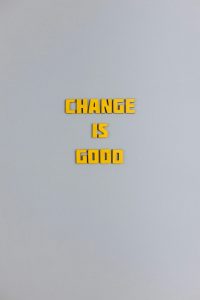
Photo by Thirdman: Pexels
Seasons change, it officially turned fall here in West Michigan but you wouldn’t know it. We’ve had near record-breaking temperatures! Making it hard to believe it’s fall. I for one am very grateful for a few extra summer-like days.
I cleaned and refreshed the hummingbird feeder in the yard for likely the last time recently. I noticed a couple of hummers a week or so ago but have not noticed anyone since. They move south in the fall and return in the spring to our area. Along with the darker mornings, spent flowers in my yard and leaves that have started to fall; I hate to see my little hummer friends go!
I have to admit that accepting the reality that change is constant, isn’t always an easy task for me to do. I am a creature of routine and habit. Sameness is easy and comfortable. Change often is not.
On the other hand, sameness can get old, boring and dull and change does bring growth and new opportunity.
Since I don’t have control over the sun and how the earth moves around it, I probably need to adjust myself to that which I cannot change. And I need to remember that which I can change is my perspective and attitude and way of thinking.
Some things are certainly easier to recognize my lack of control over. Others are not so easy to determine. My wise self the blend of my emotion mind and reasonable mind can help me to make that determination.
The Serenity Prayer offers a useful tool to tap into our wise mind when we need to.
“God grant me the serenity to accept the things I cannot change, the courage to change the things I can and the wisdom to know the difference.”
Becoming aware of my resistance thinking is the first step towards my acceptance of change. We need some quiet internal space to accurately see where our thoughts are leading us. Once I recognize my resistance I am more capable of making the distinction between what I have and have no control over.
I can change my thoughts to what fall brings rather than what fall takes away. Fall brings apples, less weed pulling to do, pretty colored leaves to look at, cooler temps to wear fuzzy warm sweaters in. It brings mom’s yummy apple pie, a brightness in the color of the sun, meals with mashed potatoes and gravy. Suddenly fall doesn’t seem all so bad!
What helps you accept changes in your life?
If you have struggles accepting change in your life and find yourself filled with intense unrelenting sadness or worry, Depression Therapy, Anxiety Therapy can help.
Do contact me today!
JD’s Midlife Tools For Living Practices, Holland, MI
Offering Heartfelt care, Compassion and Coping Tools!

I do go about living on autopilot more often than I like to admit. It happens when I take life or my circumstances for granted. And when I am barely aware of what is going on around me. Also when I default to my “automatic” ways of being, thinking and doing in certain situations.
I am living on autopilot when I meander about without any thoughtful focus. And when I’m going through the motions of life almost unconscious like. Also when I’m not aware of how I’m acting.
One day I recall driving home from work along a very familiar route from the south side of Holland, MI to the north side. After having gotten to the other side of a stop light I recall hoping the light I just drove through was green! I was living on autopilot driving home from work that day. I really did not recall if the light was red or green.
Breathing a sigh of relief I was grateful that no one was hurt and looked in the mirror to see the light was indeed green.
Imagine what it would be like to show up for an activity with the intention to get the most out of it. Or what it would be like to intentionally look for the positives in a person and let go of judgments—that person you’re looking at could even be you. Or what it would be like to not have the problems you encounter today define how this day goes for you.
Mindfulness is the practice of living in the present moment, paying attention on purpose and not judging but rather fully accepting what is happening—right here, right now.
When we are mindful of our thoughts they have less power over us. Thoughts are after all just thoughts. Thoughts simply come and go unless we become attached to or fused with a thought. We then cling to it instead of letting it move on down the river of thought that flows through our mind all day long.
Judgments are simply just one kind of thought. We can intentionally see a judgment for what is it—a thought that can be let go of and does not need to be clung to and believed and acted upon.
An intentional practice of mindfulness can help us live life more fully and be more at peace in our daily lives. It can help us is we suffer with anxiety and depression too.
Like anything else in life, it does takes practice and practice and practice to learn. And even more practice to maintain a skill. It just does!
You might consider incorporating an intentional mindfulness practice into your life.
For tips and tools, check out these wonderful resources:
DBT Self Help.com, Mindfulness
Mindful.org, How to Meditate
Also consider professional help especially if your anxiety or depression is interfering in your daily living.
Do Contact Me to begin Anxiety Therapy or Depression Therapy today!
JD’s Midlife Tools For Living Practices, Holland, MI
Offering Heartfelt care, Compassion and Coping Tools!

Photo by Jack Sparrow at Pexels
Ever wonder how best to talk to someone when they are filled with anxiety? It’s not easy to know what to say. Sometimes we can say things that really don’t help but rather hurt. Read on to learn some tools to help your friend best cope in the moment with anxiety.
When we say things like this it minimizes the persons experience. In reality the person most likely has used the tools they know to help themselves. Their anxiety experience is largely an involuntary reaction like a racing heartbeat, sweating, shaking, upset stomach, racing thoughts.
Rather, say that you can see they are scared right now and ask if you can sit and join them. Show some kindness and warm empathy. Or suggest you both go someplace quiet and go for a walk. An opportunity to decompress might be very helpful.
It can add to the person’s edginess, wondering if they’re doing something wrong. To your friend what they are anxious about it a big deal and that is what is important. Anxiety is not responsive to logic, it’s all emotion.
To really help, let them know what they are going through is hard and ask them if they’d like to share what is on their mind. Be a lending ear and let them externalize what they are going through. This can offer them some space between themselves and their worries. And help them to put things in perspective.
You are communicating your contempt of this person and judging them. If you are frustrated with your loved one’s anxiety this is something for you to work on for yourself. It’s not your friends’ job to fix it for you.
It’s more helpful to say you’ve noticed they are tenser and ask if everything is ok. By being curious you open the door for your loved one to share with you. You’ve noticed, you care and are concerned. And you are someone safe they can open up and share their worries with.
In reality your loved one might be worrying about something that really could happen or has no chance of it. You don’t know till you understand what is on their mind.
To be useful, help your friend talk through potential outcomes and make plans for how to handle each one. They will gain perspective and be prepared.
It deepens a person’s self-doubt to hear this. Self-doubt goes hand in hand with anxiety. Know your loved one already feels like a burden. Comments like this create even more anxiety for your loved one.
Instead let them know that their reaction makes sense given what they have been through. This reassurance affirms them and their emotional experience.
Know that your friend truly is not able to easily let whatever it is go. Saying ‘just stop it’ is hurtful. If they could have just stopped it they would have, right?
Rather, you might ask them to sit down and take three deep breaths with you. Doing simple breathing work might be just enough to reset their nervous system. And allow the panic to dissipate.
When we say “at least… it’s not worse “ it tells your loved one their experience isn’t important.
We might be trying to be comforting but shifting attention away from your friend’s experience doesn’t help them. It says to them they don’t matter to you.
A better approach is to let your friend know you care and what they are dealing with is hard for them. To be supportive all we need to do is acknowledge someone’s pain.
Shame often accompanies anxiety. Getting rid of anxious thoughts is not a matter of will power. Toxic positivity isn’t a cure for anxiety. One’s life experience, biology and environment are all part of the complex nature of anxiety.
What’s more helpful is to let them know they are not alone, you are there. Say you realize they are doing the best they can and that is really is ok to feel anxious sometimes. By doing this you are acknowledging them, their efforts and not adding to their shame.
Are you very worried about your loved one? You can gently encourage them to reach out for Anxiety Therapy and assist them in getting the process started if that might be helpful as well.
If you find yourself struggling with a loved one’s anxiety and it is becoming very difficult for you, know that it’s ok for you to reach out for therapy. Watching a loved one struggle emotionally is very painful. Do get the support you need!
Contact me today!
JD’s Midlife Tools For Living Practices, Holland, MI
Offering Heartfelt care, Compassion and Coping Tools!

Image by Freepiks
We know that extreme heat puts people at risk for having heat related illnesses like heat exhaustion and heat stroke. Now we know that heat in the extreme also has serious effects on our mental health too!
Heat raises your body’s level of cortisol. Cortisol is a stress hormone that is located in your brain. The rise of cortisol can affect our behavior and create mood changes.
This increased stress we feel can make people irritable under the right circumstances. And can lead to increased aggression, including incidences of domestic violence.
Extreme heat increases irritability, symptoms of depression and anxiety and even suicidal thoughts and actions. Even a slight bump in the average monthly temperature leads to increases in suicide and suicidal behavior.
Sleep difficulties are associated with extreme heat and contribute to and further exacerbate mental health symptoms. This is due to a rise in the levels of cortisol in our bodies.
Excessive heat can alter our levels of serotonin a neurotransmitter that helps regulate mood, behavior and sleep. And may lead to changes in mood such as anger, frustration or irritability.
High temperatures are linked with memory problems, attention and reaction time changes.
Higher heat is connected with increased substance use.
Alcohol is a diuretic. It increases urine production and leads to fluid loss. If alcohol is not balanced with sufficient water intake it causes dehydration. This is especially so during times of extreme heat.
Those of us especially vulnerable to the impacts of extreme heat are older adults, children and those of us with preexisting mental health conditions.
Studies report days with higher-than-normal temperatures during the summer are linked with increased rates of visits to emergency departments for mental health-related conditions. This includes mood disorders.
People with dementia have an increased risk for hospitalization and death during heat waves.
If you are taking some psychiatric medications, including certain antidepressants and antipsychotics you might be at risk. These medications can affect the way a person’s body regulates temperature.
Certain antidepressants, antipsychotics and benzodiazepines can also decrease thirst sensations. As a result people aren’t aware they’re becoming dehydrated.
If you take lithium do know it causes the kidneys to release more water creating more urination and sweating potentially causes dehydration. As a result, lithium levels in the body can become concentrated, and that can be toxic.
Importantly do consult with your doctor if you are concerned about any of your medications.
We are all encouraged to stay hydrated and take precautions. This is especially true for those of us who are more vulnerable to extreme heat.
It’s important to check in on those people you know who may be more vulnerable to extreme heat conditions to see how they are faring.
In periods of extreme heat do stay in a cool environment as much as possible during. Do drink plenty of water to stay hydrated! And do try some stress-management tools like meditation to decrease your stress level.
This great website can help you get a start learning and practicing with meditation: Mindful.org How to Meditate
If you find the stress of dealing with the excessive heat is overwhelming you, do reach out for help. With Depression Therapy and Anxiety Therapy you learn additional stress coping tools!
JD’s Midlife Tools For Living Practices, Holland, MI
Offering Heartfelt care, Compassion and Coping Tools!

As we travel on the road of life we do encounter numerous events that shake the foundation of our being. It can certainly feel like we’ve been smacked in the face. Here we are traveling along and ‘bam’ a “we sure didn’t see that one coming now did we” event happens.
We want to keep on the same road we were on, but that path has really vanished. Or its’ changed so drastically we end up lost. We can’t seem to find our way.
We don’t really have a choice. The road we were traveling on is gone. We can’t stop time. Can’t go back. We can’t change what is. Can’t change what’s happened. If we try to, we get stuck and end up filled with suffering and misery.
We can become resentful and bitter. A part of us can feel like we’ve stopped living. Depression sets in.
The choice we do have is to become willing rather than willful. Willingness is about opening ourselves to what is or what has happened rather than to wish it were different and regret how the road of life has changed so dramatically. When we practice willingness, we stop adding to our pain.
Life provides opportunities for me to glance back and see just how I’ve held on to a road of life in the past that had actually vanished. In truth my want for that particular road held me back from living fully in ways I didn’t realize until I saw that invisible fork in my life road clearly.
And, when I’ve looked back to that time of my life I see that my want for that path created pain in the present moment. I added suffering wishing for my road of life to have been different in the past.
Seems obvious to me now but for a very long time I didn’t see my longing for something no longer there clearly. By doing so, I have begun to open myself to accept what happened and feel lighter as a result.
I do know I would not be right here right now if that life road I was on hadn’t twisted and turned as it has. Everything unfolds as it does. It just does.
If you find yourself stuck wishing for a past road that can no longer be traveled upon consider practicing willingness.
You can learn more and ways to practice with willingness from this wonderful resource on the DBT Self Help website:
Willingness & Half-Smile
If you need some assistance exploring those ‘invisible’ forks on your road do reach out for professional help. Especially do so if depression is preventing you from living life fully!
Do Contact Me to begin Depression Therapy today!
JD’s Midlife Tools For Living Practices, Holland, MI
Offering Heartfelt care, Compassion and Coping Tools!
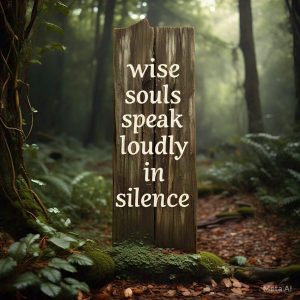
I’ve come to savor early morning quiet times. Early morning time outside is even more special for me to experience. This silence is golden to me.
Such truth there is in this old proverb. Silence is golden and not just when saying nothing is better than speaking.
When I read the meditation booklet, Daily Word, A Unity Publication for March 5, 2016 it reminded me of the value of silence: “Deep beneath the random and shifting waves of my mind, I discover a vast ocean of peace. Like an ocean’s choppy surface, my outer mind may seem busy or even stormy. As I stop and let my awareness turn within, I find a still, quiet place… In the silence of my being, I find comfort and serenity.”
Many years ago, my husband and I were hiking in the Porcupine Mountains in the upper peninsula of Michigan. It’s a beautiful place that is far away from well-traveled and busy areas. It is quiet up there.
I remember sitting by a small lake listening to the silence around me. Yes, I was listening to silence. I recall whispering to my husband about the silence too not wanting to intrude into its vastness and break it.
It’s not easy to find silent places in the world I live in here in Holland MI. Even in the quiet of early morning or late at night in the woods around my home there is a hum in the distance from the small city not so far away that echoes in the silent air.
I’ve noticed moments when snow that is gently falling dampens sounds in the distance and there has been a quiet surrounding me right in my very own yard.
These are golden moments of silence to me. They are rare opportunities and I savor them.
Early mornings before the world begins to stir is my time to sit with silence, be still and turn inward. It’s in my alone quiet time that I come to remember I am not so very alone at all…a quiet golden path to peace.
Silence might be difficult to embrace. It can be hard to relax when the world around us is silent. We can get caught up in the thoughts spinning in our minds especially if we have anxious thoughts. Making silence something we choose to avoid.
If this is true for you, practicing mindfulness might be a tool to practice with.
Check out these other blog posts of mine to learn a bit more about mindfulness:
Mindful of Judgement
In addition, this website offers some great free mindfulness practice tools to utilize:
Mindful.org
If your anxiety is just too high to allow you to sit comfortably in silence Do Contact Me. Anxiety Therapy can help you learn to quiet your mind.
JD’s Midlife Tools For Living Practices, Holland, MI
Offering Heartfelt care, Compassion and Coping Tools!

Image by freepik
Ever wonder how you ended up thinking about what it is that you have on your mind? I do…a wandering mind I sure do have. Often, I realize I’m thinking about something and out of curiosity I will pause and trace back to what I had been thinking about that took me to my current thought destination. It always amazes me how I got to where I got.
My wandering mind is like a dog on one of those long retractable leashes that goes and goes and goes until its owner realizes it is time to reel the dog back in.
I can be off on tangents very far removed from my original thought. Much of the time it’s not a bad thing when my mind wanders as our minds just do. It’s the way our very human brains work. They are built to think.
Sometimes it isn’t very helpful to end up in the very place my wandering mind has taken me. I can end up living too much in my head rather than fully present living in today. And miss out on actual life going on around me.
My mind can be much like a dog on a long leash who has gotten all wrapped around a post and can’t make another move.
I can get all caught up in worry about any number of things and end up all tangled up feeling anxious or depressed. And then I worry more and feel more anxious and depressed. It can be a vicious and painful cycle. And I get stuck.
It’s not until I can get a grip just like the owner of the dog on that long retractable leash and reel my thoughts back under my control that this vicious cycle and pain comes to an end.
We can become more aware of our thinking and notice when we’re in a place we don’t really need to be. And decide where to put our focus and gently bring our mind back to that chosen place each time that darn dog gets running wildly on that long leash once again.
Remember this takes practice and practice and practice. And then more practice too. It just does!
It’s important to be gentle with ourselves when our mind tears off running over and over again and again. And take a breath and relax as we practice too. We are after all simply an imperfect human beings and living is all about the opportunity to learn!
Where is a helpful place to focus your mind’s attention when you notice a need to reel in your unhealthy thoughts?
Do Contact Me if your wanting mind is out of control and you need some assistance reeling it back in! Depression Therapy and Anxiety Therapy can help!
JD’s Midlife Tools For Living Practices, Holland, MI
Offering Heartfelt care, Compassion and Coping Tools!
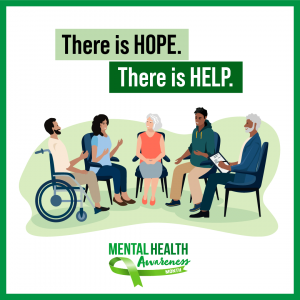
Did you know that your mental health is essential for your overall well being at every stage of your life? That being said it makes good sense then to invest time and energy to make your mental health a priority!
Since May is Mental Health Awareness Month it’s a perfect time to do a check in to see how well you are doing.
It’s likely you’ve been feeling a bit more stressed of late. You are not alone either. All one has to do is turn on the news or read an article or post on social media and bam we are hit with barrage of negativity.
Feels like the world is shouting at us from all directions. It’s noisy, loud and in our faces no matter where we look too. People are worked up, some scared and some angry. Even when driving we can encounter the intensity of those around us.
All this can lead to feeling more anxious, drained, perhaps a bit depressed too. We all are carrying a load these days. Sometimes we can’t really afford to power through it all.
Consequently we need to pause, recognize our emotional distress and find some tools to take good care of our emotional well-being.
It might seem kinda obvious, but really just how often do you ask yourself how you are feeling — and then pause to really consider your response?
Checking in on your mental health starts with assessing how you are feeling. Do you notice feeling stress, anxiety, worry, sadness, anger, irritability, depressed or other challenging emotions?
Use a scale of 1 to 10 to determine just how much of the emotional distress you carry with 1 being little and 10 being the highest. It can help to take note of how you feel at the same time each day.
Keep track in a notebook or journal, or simply keep a mental track of your numbers. If your number goes up, that’s a sign you need to pay attention to your mental health.
It’s also important to notice how you’re feeling physically, too. Some ways mental health concerns can show up physically include:
*Stress: Headaches, body pains, skin rashes, or worsening of chronic health problems
*Anxiety: Headaches, stomachaches, muscle tension, or frequent urination
*Depression: Appetite changes, weight loss or gain, loss of energy, and unexplained aches and pains
So, take note of any of these physical symptoms of stress too!
So, turn your phone off or put it on do not disturb for a set period of time that you determine is needed for your peace of mind. Give yourself permission to disconnect from calls, texts, emails, alerts, social media, Facebook and the news too.
This can help you to reclaim some calm and a sense of control.
After all, the world will be there when you get back to it! And that’s whether you like it or not too!
We can ease anxiety and distress by noticing and focusing on our breathing. By taking a few deep, intentional breaths we can shift our entire mindset.
One way of practice is to: 1) Breathe in slowly. 2) Hold breath. 3) Breathe out.
Notice the breath coming into your nose and filling up your chest as it expands. Notice what happens as you hold your breath and then what occurs as you exhale. Doing this for just 60 seconds can lower your stress level.
When you practice breath focus you remind your nervous system that you are safe and there is no need to be on red alert. And then your system calms down with you.
By taking a walk-in nature, a hike through the woods, a group fitness class, or going to the gym you can increase your energy levels, reduce depression, and boost your mental health well-being.
Dance around the house while you do chores. You will not only get your work done, but dancing reduces levels of cortisol, a stress hormone in your body and increases endorphin’s, that are your body’s “feel-good” chemicals.
Stretching, yoga, tai-chi can all help with managing stress, relaxation, getting better sleep and are a way to help improve our mental health.
What are you doing to bring yourself joy? Can’t think of anything? Might be time to change that.
With so much to do and so much going on it’s easy to push leisure to the bottom of the pile. Taking time and making opportunity to be happy is important to your mental health.
Here are a few ways to incorporate joy into your life:
*You can create a gratitude journal. Write down three things you are grateful for each day. Gratitude is a powerful way to shift your outlook. Seeing the glass half full is a wise perspective. Especially in the midst of challenges there are still things we can be thankful for.
*Do something new—plan a mini getaway, get creative with a new recipe, try painting a picture, do a new craft project, write a poem. Creative expression and positive well-being are linked and help relieve stress and anxiety too.
*Laugh—watch a funny movie or television show. Visit with loved ones who make you smile. Go hang out with a funny friend or check out funny videos online. Laughter helps reduce anxiety. Let laughter and smiles warm your heart.
*Spend time with a furry friend—your dog, cat, or another loving pet. Time with animals actually lowers the stress hormone – cortisol, and boosts oxytocin – which stimulates feelings of happiness. If you don’t have a pet you might hang out with a friend who does or volunteer at a shelter.
*Go sit outside in the sun for 15 minutes. Don’t forget the sunscreen. Sunlight synthesizes Vitamin D that experts believe is a mood elevator.
*Put a smile on your face. While it may not be easy to do, smiling does help to lower your heart rate and calms you down.
Having a strong support system is important for our mental health. Do you have someone(s) in your life who you consider trustworthy and loving and you can turn to when you need it most? If not perhaps it’s time to build up your support team.
Support team members can be a partner, sibling, healthcare provider, faith leader, friend or other trusted individual.
Do have at least one person in your life who you can trust to: give good advice when you need and ask for it, is respectful and trustworthy, gives you space to make your own decisions, grow, and even make mistakes too.
Also have someone(s) who actually listens to you and has your best interest at heart.
Support groups are a resource to find a group of people who can relate to your challenges and provide support. There are numerous kinds of support groups in every community too. Call 211 a help referral source here in Michigan to find a group near you.
Also, give yourself permission to reach out for professional counseling if your mental health is making it hard to function well with all the challenges you face.
Above all, remember that recognizing we need help and asking for it is indeed a strength!
Do Contact Me to begin therapy today! Don’t wait to take good care of yourself!
Anxiety Therapy, Depression Therapy, Grief Therapy, PTSD Treatment, Substance Abuse Treatment
JD’s Midlife Tools For Living Practices, Holland, MI
Offering Heartfelt care, Compassion and Coping Tool

Photo by MART PRODUCTION: Pexels
Mental exhaustion happens when your mind is tired, exhausted or fatigued. It’s a drain on your brain that happens when you are frequently on red alert or stressed out or you’ve been focused on a mentally tough task for some time.
All kinds of things can lead to mental exhaustion—your job, caring for family whether it be for kids or aging parents, coping with the stress of uncertain times for example.
*Anger or impatience—bad moods, short temper, irritation, snapping at people more often. In other words, mental exhaustion makes it hard to control our emotions.
*Decreased productivity—can’t get work done, hard to concentrate, motivation goes down, miss deadlines, easily distracted. Just doing small tasks can be overwhelming.
*Zoned out—mind wanders, drowsiness, difficult to pay attention, reaction time slows down. Car accidents are often linked with mental fatigue.
*Insomnia—hard time sleeping, tired during the day. Lack of sleep makes mental exhaustion worse.
*Increased alcohol or drug use—drinking or using more drugs to help manage stress and control impulsive behavior. For those who have a substance use disorder mental exhaustion takes a bigger toll.
*Depression—move in slow motions, little energy, feel numb or hopeless. Mental exhaustion can make it hard to finish work projects or do daily activities.
*Anxiety—worry, panic. Mental exhaustion triggers the sympathetic nervous system ‘flight’ or ‘fight’ alarm bells that say something is wrong.
*Physical activity decrease—exercise tolerance decreases. It takes more energy/effort to move than it once did.
*Eating habits change—may crave sugary, salty or fatty foods or may not be hungry at all.
*More mistakes—can’t easily catch and fix mistakes quickly or at all.
*More pain—experience more headaches, sore muscles, back pain, stomach problems. Ongoing health problems hurt more than usual.
Do you notice any of these symptoms in yourself? If so perhaps it is time to do something to help yourself! Don’t let the consequences of your mental exhaustion get worse.
Importantly, take short breaks when you are doing mental work. Take a break every hour or 2 for a few minutes.
Use the Pomodoro Technique: Set a timer for 25 minutes and focus on one task the entire time. When the timer goes off take a 5-minute break. After 4 sets take a 15-30-minute break. And repeat until your work task or workday is done.
Exercise during your breaks do jumping jacks or stretches or take a 10-minute brisk walk.
Certainly do find a way to relax and learn to switch on your natural relaxation response when you need it the most. For instance, activities like massage, meditation or yoga can help you learn how to calm your system down.
Get support from friends or family.
Most importantly reach out for professional help. Do so especially if your depression or anxiety is creating intense despair and hopelessness for you.
Unfortunately, we can’t avoid the stressors that life brings or the mental exhaustion that can accompany living life’s challenges. However, we can make self-care a priority. So just what will you do for you today?
Do Contact Me to begin anxiety therapy or depression therapy today! Don’t wait to take good care of yourself!
JD’s Midlife Tools For Living Practices, Holland, MI
Offering Heartfelt care, Compassion and Coping Tool
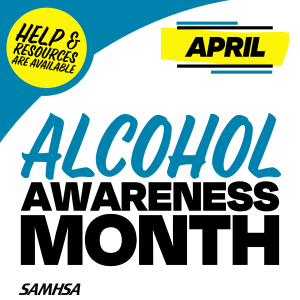
Alcohol awareness question 1: Do you know how an alcohol drink is measured as in I only had one or two? Alcohol awareness is important to have. Well, here in the United States, a “standard drink” is any beverage containing 0.6 fluid ounces or 14 grams of pure alcohol. So exactly what does that mean?
*12 ounces of regular beer, about 5% alcohol
*8-10 ounces of malt liquor or flavored malt beverages such as hard seltzer, about 7% alcohol
*5 ounces of table wine, 12% alcohol
*3-4 ounces of fortified wine, 17% alcohol
*2-3 ounces of cordial, liqueur, aperitif, 40% alcohol
*1.5 ounces of brandy or cognac, about 40% alcohol
*1.5 ounces or a shot of distilled spirits—gin, rum, tequila, vodka, whiskey, about 40% alcohol

Say beer…what equals 1 standard drink? 12 ounces. So, 16 ounces is 1 1/3 drinks, 22 ounces is 2 drinks and 40 ounces is 3 1/3 drinks.
With malt liquor 12 ounces is 1 ½ drinks, 16 ounces is 2 drinks, 22 ounces is 2 ½ drinks and 40 ounces is 3 1/3 drinks. Malt liquor has more alcohol content.
A regular size bottle of wine (750 ml) is 5 drinks!
With 80 proof distilled spirits—a shot is 1 drink. A mixed drink or cocktail has 1 or more drinks in it depending on the number of shots in it. A half pint is 4 ½ drinks and a pint or half bottle has 8 ½ drinks in it.
Guess how many drinks in a fifth…17 drinks!
Alcohol misuse includes binge drinking and heavy drinking. Misuse of alcohol increases your risk of experiences harmful consequences due to drinking. The more drinks you consume on any day and the more alcohol misuse over time and the greater the risk you have for developing problems.
When someone binge drinks they have a pattern of drinking alcohol that brings their blood alcohol concentration (BAC) to 0.08%. This typically happens when a woman has four or more drinks, or a man has five or more drinks, within about two hours.
Heavy drinking for women is consuming four or more drinks on any day or eight or more per week. And for men consuming five or more drinks on any day or 15 or more drinks in a week.
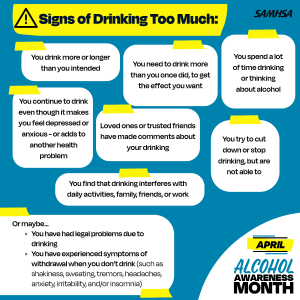
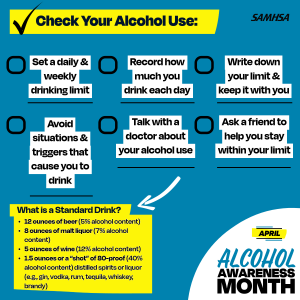
If you would like to learn more including how alcohol affects your health check out the Substance Abuse And Mental Health Services Administration website and explore this resource:
Now that you have increased your alcohol awareness, if you are concerned about your own or a loved one’s alcohol use know it is ok to reach out for substance abuse treatment. Do Contact Me today!
JD’s Midlife Tools For Living Practices, Holland, MI
Offering Heartfelt care, Compassion and Coping Tools

Image by erik-karits-2093459 on Freepik
Hey West Michigan the song birds are back! And, they are very happily singing away outside. Give yourself a mental health break and do go have a listen.
At one point on my walk I was surrounded by a variety of bird tunes. Literally it was like surround sound outside. The tune they all created just for me was beautiful.
I stopped walking and stood listening for a bit in awe and amazement. In addition I found myself smiling both inside and out. The chorus was just so delightful.
From such little bodies come such huge voices. They so freely give of their energy and spirit and bring such joy. They sound so happy too. It’s hard not to feel some of their excitement when you have a listen.
When was the last time you stopped and delibertly gave yourself a time out opportunity to improve your mental health? Research has shown being out in nature and hearing birds sing is beneficial for our mental health.
For more information about the benefits of listening to bird songs check out my blog post:
Looking for a way to improve your mental health?
Go give yourself a little mental health break. You might go for a walk, stand in your back yard, take a drive to find a wooded area and open your car window, head to a park to take a hike, have a sit on your front porch.
Most importantly open your ears, close your eyes and have a listen. Be present and savor the gift the song birds are creating just for you!
It is clear to me those little feathery friends of ours are glad to be back. Their joyful tunes tell me so. I for one am most happy to hear them singing once again.
I notice the tunes more keenly this time of year. So many of them are gone for the winter. It’s very apparent song birds are back. And I am grateful for the joy they bring to my heart!
So you can give them a chance to bring a smile to your face and in your heart too! All you gotta do is take a little mental health break and head outside. I wonder who is singing and what song they are creating now?
If you are looking for other ways to give yourself a mental health break especially if you are dealing with depression or anxiety or grief, Do Contact Me today to begin therapy and learn some additional life coping tools!
JD’s Midlife Tools For Living Practices, Holland, MI
Offering Heartfelt care, Compassion and Coping Tool
